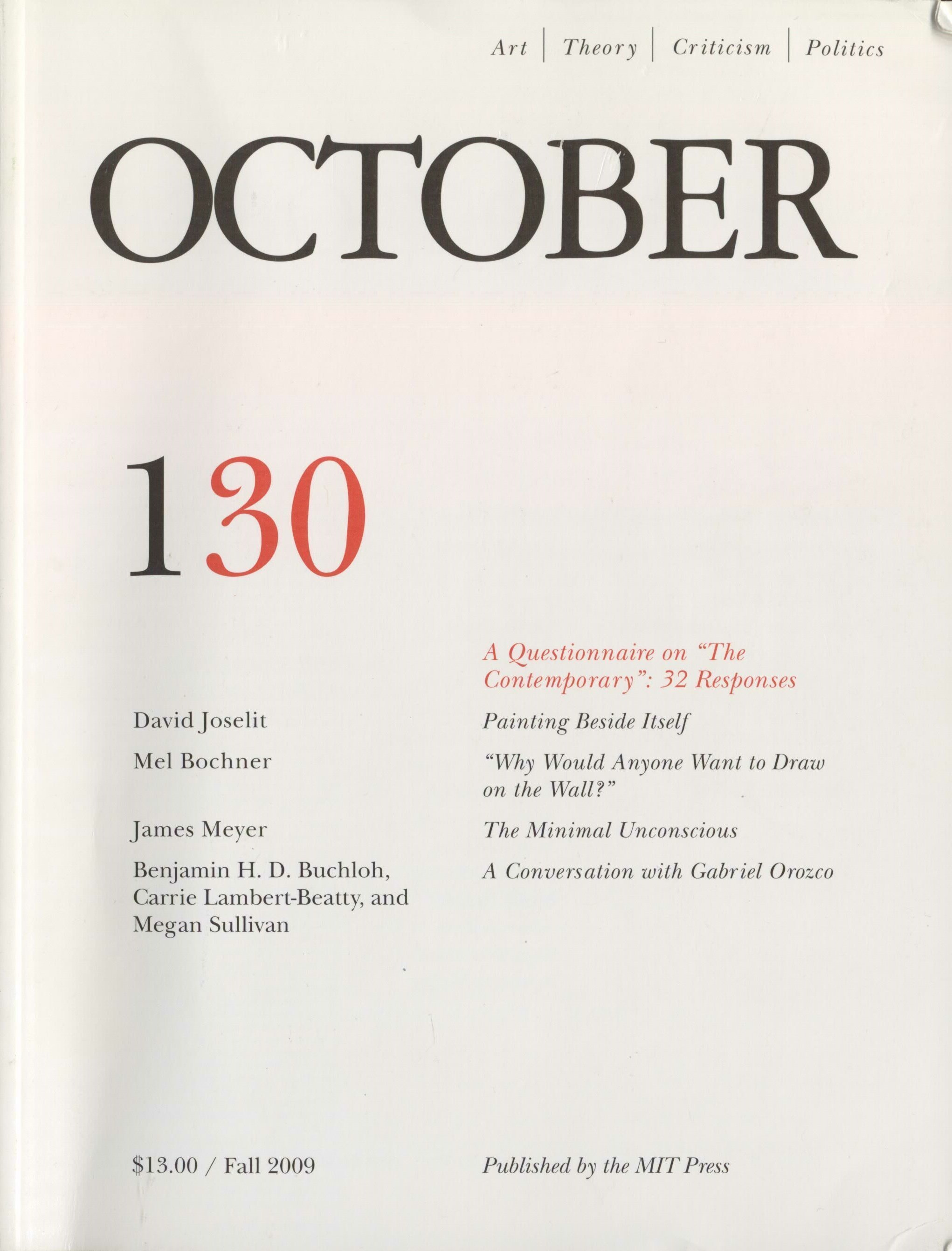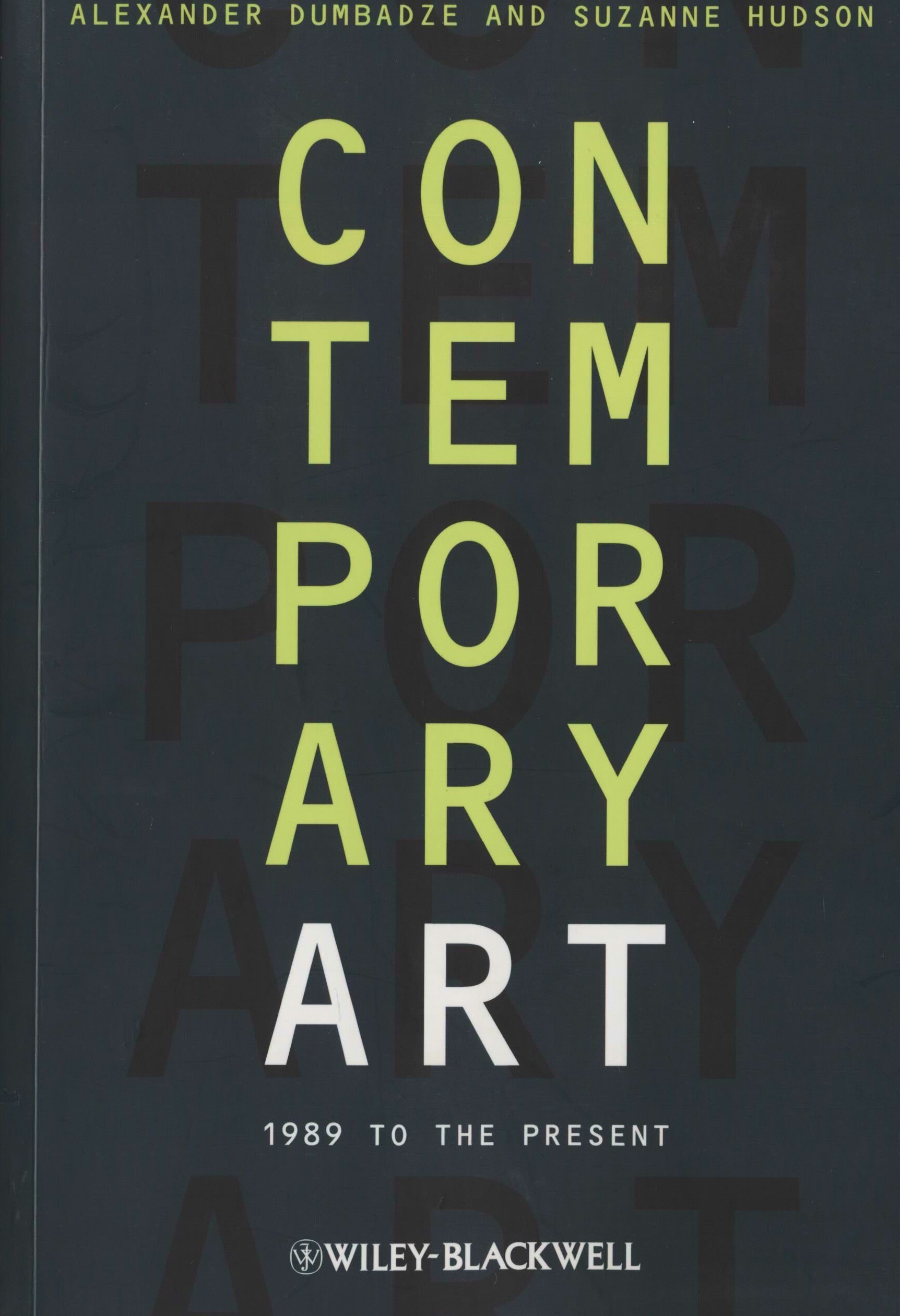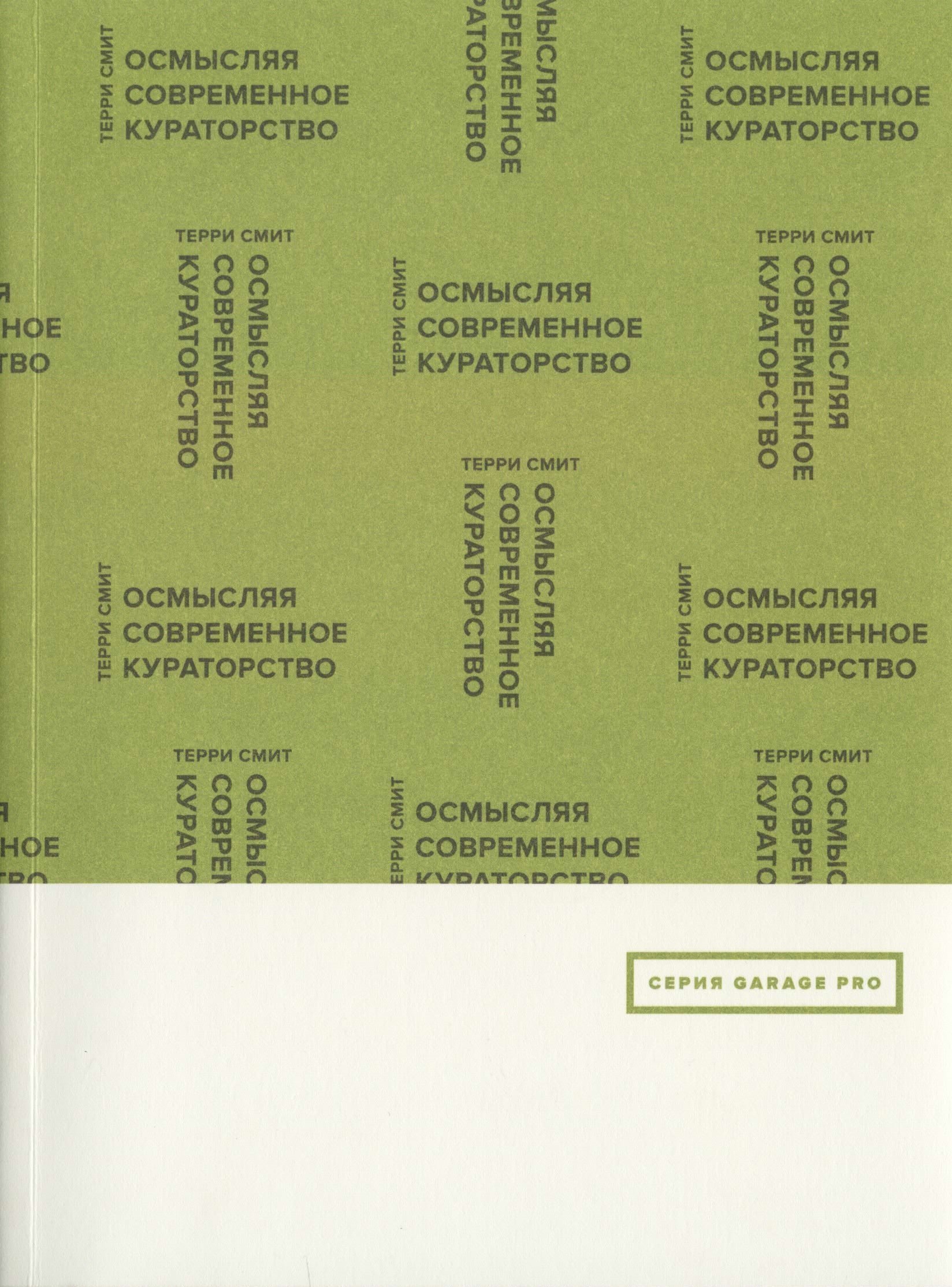With volumes written on the term “contemporary” in relation to art practices and hundreds of publications discussing the difference between modern and contemporary art, a complete overview of sources on the subject in one article seems impossible. This selection of books, available in Garage Library, offers an introduction to one of the central problems in art theory.
Publications on the concept of “contemporary” in contemporary art
Overview by Ilmira Bolotyan, Maryana Karysheva and Valeriy Ledenev

Questionnaire on “The Contemporary”
October 130 Fall 2009. – pp. 3 – 125.
In autumn 2009 October asked a number of American and European critics and curators to define “contemporary”. Paradigms like “the neo-avant-garde” and “postmodernism” have become a matter of the past without giving place to a new grand narrative, while today’s art practices seem to float free of historical determination. At the same time, contemporary art has long been institutionalized: universities and museums run contemporary art courses and programs, overseen by corresponding departments. The question is: how real is such indeterminacy? Is it rooted in the local context and what are its causes?
Some of October’s respondents focus on the contemporary art discourse in academia. Julia Bryan-Wilson points out that the main task in teaching contemporary art is not so much to analyze contemporary trends but to predict future ones, while Grant Kester reminds us that only a few decades ago contemporary art was not part of the standard academic program, and was commented on by journalists and not scholars.
James Elkins dismisses the concept of “contemporary” as useless in the postcolonial age that has rejected grand cultural narratives in favor of small or local models.
According to Richard Meier, today’s students writing on the history of art increasingly focus on the current situation: artists of their own generation, recent exhibition projects or biennales — while their arguments are increasingly based on recent theory and critique.
Mark Godfrey argues that artists, curators and critics, have begun to feel ambivalent about the very idea of the contemporary, if the contemporary is understood as belonging to one’s own time. Artists no longer see their practice as a development of, or dialogue with the past generations. Reflecting on their own position in the world, they often resist economic, social and political conditions of the present and are not particularly interested in the opportunities of the present, which means they do not use new technologies to articulate their protest. T.J. Demos places the emergence of the field of global contemporary art in 1989, a year marked by the fall of the Berlin Wall, the culmination of perestroika in the USSR and liberalization in China. These have led to the emergence of a network of international exhibitions around the world. This was globalization, a new global narrative, which reflected the triumph of neoliberal economy in art. Invoking the terms of Jacques Rancière, T.J. Demos calls on us to rethink globalization as an aesthetic-political project that challenges the forces of economic, social and political inequality, bringing alternate systems to life. M. K.

Клэр Бишоп. Радикальная музеология. [Claire Bishop. Radical Museology]
М.: Ад Маргинем Пресс, 2014. — 96 с.
Discussing the history of “the contemporary”, Claire Bishop, professor at the City University of New York, points to the flexibility of the term. What used to stand for “post-war” in the 1990s, later came to mean “starting in the 1960s”, and is now often associated with the period from 1989 to the present. According to Claire Bishop, neither of these chronologies is completely correct. China, Africa and India, she argues, will have different histories of contemporary art, dating back to different decades, and no chronology will encompass what has been going on in every part of the world, which means “contemporary” becomes a discursive category or a question of temporal disjunction.
Bishop proposes two discursive approaches to defining “contemporaneity”: either it denotes stasis or a break with postmodernism by asserting a plural and disjunctive relationship to temporality. The latter approach, she argues, is more generative: it envisages a “dialectic contemporaneity”, where multiple temporalities coexist within a more politicized horizon. Not only should we be aware of the fact that different periods are present in every historical object, but we should ask ourselves why particular temporalities appear in particular works at a particular moment. To resist our contemporary presentism — or obsession with the present moment — we need to remain focused on the future: ‘the ultimate aim is to disrupt the relativist pluralism of the current moment, in which all styles and beliefs are considered equally valid, and to move towards a more sharply politicized understanding of where we can and should be heading’.
Bishop believes that museums with historical collections have become the best testing ground for a non-presentist, multi-temporal contemporaneity. Criticizing presentist thematic hangs, she discusses a number of new collection display paradigms that present a new category of contemporaneity: the Van Abbemuseum in Eindhoven, the Museo Nacional de Reina Sofía in Madrid, and the Museum of Contemporary Art Metelkova (MSUM) in Ljubljana.
Each of the institutions discussed has displayed its collection to suggest a provocative rethinking of contemporary art in terms of a specific relationship to history. The Museum of Contemporary Art Metelkova, whose catalogues are also available in Garage Library, has to reconcile the desire to represent the nation-state with the need to find its place in the transnational world of contemporary art. The solution offered by MSUM curators is self-reflection: an attempt to compare the ideals of Yugoslav ‘self-management’ with the ‘authentic interests of contemporary art’.
Thanks to their clear political programs, Bishop concludes, the three institutions in question stand out among the presentist museums whose exhibition policy is determined exclusively by market interests. I. B.

Дэвид Джозелит. Об агрегаторах [David Joselit. On Aggregators]
Художественный журнал №95 2015. - С. 112 - 122.
Until recently, David Joselit writes, the term “contemporary” was a neutral descriptor indicating an object’s or phenomenon’s recentness or belonging to its time. Today, it has acquired an ideological flavor. “Contemporary” has replaced the styles and movements of the past: it is a global language, more or less shared by artists and art professionals around the world.
As a methodological framework for a description of contemporaneity, Joselit chooses the concept of international style: international style is the dialect contemporary art speaks. “The distinction between a “period” and a ”style” may sound purely academic, but there are important distinctions: Periodization suggests a succession of visual languages, a string of new paradigms, whereas an international style encompasses the adoption and adaptation of an existing idiom by a culturally and geographically diverse, even unlimited, array of producers. <…> an international style arises when a visual language has reached a point of saturation, when its dissemination has allowed it to become legible throughout a global world.”
Style implies a number of common characteristics and simultaneity of their manifestations. However, international style and contemporary art are rather defined by uneven development conditioned by globalization. International style is “a frame of potential growth”, a dialect open for individual interpretations.
Unlike a style that has emerged in a particular time and space and was then exported to new territories, international style does not only foster “the standard”, but encourages the invention of new lexical formats, which invite enunciations related to particular time and places and thus having “rhetorical urgency <…> eloquence, and even <…> beauty”.
Aggregators, exemplified by curated communication circuits like Contemporary Art Daily or Art.sy, are a perfect model of “the contemporary”. Aggregator is a model of accumulation where relatively autonomous elements retain their values and ideals.
On the other hand, aggregators (and therefore contemporaneity) are characterized by uneven development and asynchrony that has to do with local differences (compare the history of contemporary art in the former Soviet Union, Western Europe and China) as much as it is does with hierarchies within the art world and institutions rejecting anything that does not fall into the category of international style.
The model of asynchronous contemporaneity as an aggregator of various artistic and lexical forms inspires optimism. Not only it affirms heterogeneity and complexity of the world, but also it allows “asynchronous objects to occupy a common space”, and allows us to see their unique meaning without dismissing them as unimportant or secondary. V.L.

Contemporary Art: 1989 to the Present. Edited by Alexander Dumbadze and Suzanne Hudson.
Oxford: John Wiley & Sons, 2013. - 494 pp.
This collection of essays is split into several sections exploring the key issues relating to contemporary art (education, art market, the questions of media etc.). The first section is entirely devoted to the concept of contemporary, and an essay by the French philosopher Jean-Philippe Antoine offers the most interesting perspective on the subject.
According to Jean-Philippe Antoine, contemporary is not a time period which we have to accept as a given, but something we construct as we write its history. The new and the contemporary (he often uses these terms as synonyms) are inseparable from the past, but build on it by creating and affirming otherness and singularity.
“As once stated by the late nineteenth-century French sociologist Gabriel Tarde, history is above all a record of inventions,” Antoine explains. “Aside from fiction, history is the one discourse that has the potency not to dissolve invention into repetitious sameness. <...> As a consequence, a special responsibility emerges for artists and scholars to take care of the new, of the now, in terms of building for it a history.”
“That means that the contemporary,” he concludes, “far from identifying with the “present” <...> actually consists in the knitting together of a specific variety of times.”
This variety of times consists of the past moments that have determined the way we understand the present. These moments live inside us like ghosts of Christmas past, but are no longer “ready-mades of historical or stylistic periods”. Instead, they have turned into “shocking artefacts questioning our awareness of the now, and ultimately shaping our present.”
At the same time, an analysis of the contemporary gives us a key to understanding the past, which is no more predetermined than the present, but appears to a contemporary viewer as a discrete trajectory in its making, a performing history.

Терри Смит. Осмысляя современное кураторство. [Terry Smith. Thinking Contemporary Curating]
М.: Ад Маргинем Пресс, 2015. - 272 с
The writings of Australian critic Terry Smith present some of the most constructive ideas about the concept of contemporary. One of his works devoted to the definition of the term is Our Contemporaneity? published in Contemporary Art: 1989 to the Present.
To Smith, contemporary means a lived difference, coexistence of incompatible points of view in the absence of a universal art-historical narrative. Contemporaneity exists in versatile forms of the past coming to life and the desired future as seen from an experienced or a possible present. Contemporaneity cannot have strict conceptual borders and cannot be described in premade formulas. It is a form that one cannot define in advance.
In Thinking Contemporary Curating, published by Garage in collaboration with Ad Marginem Press, Terry Smith returns to the concept of contemporaneity in every other chapter. Insisting on its irreducibility to what is current or fashionable, or to some general formula, he points to the multiplicity of images of the past it offers us.
On the other hand, that which we do not see as contemporary today appeared so before, and therefore any contemporaneity has a history, which, as Smith believes, it is up to the curator to discover in different cultural phenomena (the everyday, technology, human relations, sexuality). “If we are contemporaries with the artist, the artwork makes its claim upon us in the time of our times, that is, our shared temporality,” he argues. “If we are not contemporaries with the artist, the artwork invites the possibility of such a sharing – in a past time, or an imagines other time – as an act of empathy that we know will be partial, temporary, but perhaps no less valuable for that.” V.L.
